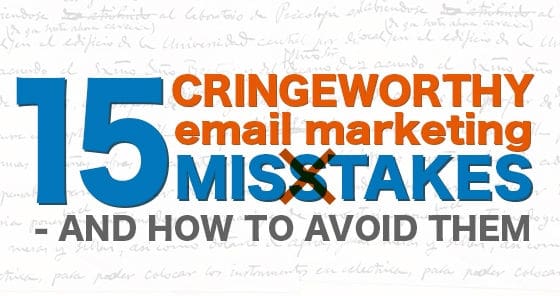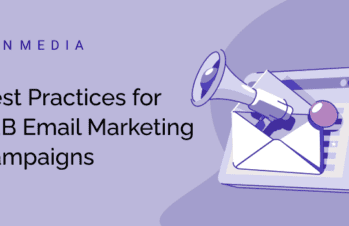Email marketing is by far one of the most effective ways to reach out to your online audience, and yet many businesses commit gaffes that are nothing short of cringeworthy when it comes to their marketing emails. We’ve put together a list of the 15 most common email marketing mistakes, along with advice on how to avoid making each one.
Mistake #1: Not having an email subscriber list in the first place.
Email addresses are extremely valuable assets to have. In fact, after your website, they’re probably most important. Social media pages are vital, but you don’t actually own them, so they get to make the rules as to what your fans see and how you can contact them. With an email subscriber list, on the other hand, you have a direct way to contact your online audience on a regular basis, and you own that list – no one can ever change an algorithm or create a new policy that cuts you off from them.
Mistake #2: Having a list – but not sending out regular emails.
Almost as bad as number one, not utilizing your email subscriber list to the fullest is another cringeworthy mistake. Yes, having that list in place is the all-important first step, but it won’t do you any good unless you are actively cultivating an email relationship with the people on that list by sending them emails on a regular basis.
Mistake #3: Not offering an incentive for sign-up.
As we said, email addresses are valuable – so you should be willing to give people something of value in exchange for that information. No one likes spam, so everyone is hesitant to sign up for yet another email newsletter – unless it’s truly worth their while. Make it worthwhile by offering something irresistible as a motivation to sign up, whether that’s a free white paper, an online workbook, or some other valuable free content.
Mistake #4: Not making email marketing a priority.
Having a subscriber list and sending regular emails is one thing…and making email marketing a priority is entirely another. The emails your online audience receives from you should not just be afterthoughts or thrown together carelessly just to have something to send. Your business needs to create an email marketing strategy, and then follow through meticulously, placing a high level of importance on each and every aspect of your campaigns.
Mistake #5: Sending irrelevant or off-putting emails.
Your email subscribers gave you their email addresses for a specific reason, so don’t betray their trust by sending them an off-topic email, or one that makes them feel you care more about their money than you do about them. Keep to the topics and themes you told them you’d be discussing when they opted in, and make reading your emails a positive experience, rather than an off-putting one, by focusing on your subscribers’ needs over your company’s.
Mistake #6: Timing and frequency mistakes.
It can be a tricky balancing act to know just when and how often to send your marketing emails, but it’s an important thing to keep in mind. Flooding your subscribers’ inboxes will make them unsubscribe – or worse, mark your emails as spam. But if you wait too long in between emails, you run the risk that subscribers will have forgotten who you are, and may unsubscribe for that reason. Sending emails at the wrong time, on the other hand, can mean the difference between a huge spike in sales and a complete lack of ROI from your email marketing campaign. The key to finding the balance? Testing.
Mistake #7: Confusing transactional emails with marketing emails.
If someone orders something from your website, they will expect to receive emails confirming their purchase, updating them on the delivery status, etc. But these emails are transactional emails, very different from marketing emails. Yes, you can include marketing elements in them, such as recommendations for future purchases, and yes, you can use a customer’s purchase history to customize the marketing emails they receive, but your strategy for transactional emails must be separate and different from your email marketing strategy.
Mistake #8: Not targeting segmented lists.
Speaking of customizing emails, this may be the simplest way to do it. Rather than sending the exact same email to everyone on your company’s email subscriber list, whether they’re interested in the same things or not, segment your audience by interest or purchase history, and send each segment emails tailored to their specific tastes.
Mistake #9: Being in a rush.
How often have you received an email apologizing for a previous email that contained a mistake? Hurrying to get an email out will only result in more work and possible embarrassment or even monetary loss, depending on the mistakes made. Will you honor a ridiculously low price, or start a sale early, if an email has been sent out saying you will? Or will you retract it with an apology – and risk the ire of your customers? Better to avoid the situation altogether by taking your time.
Mistake #10: Not checking contact name merge tags.
This one may be the most cringeworthy of all. Ever received an email that starts out with, “Hi First Name?” Be absolutely sure that you have set up your merge tags correctly – and once you’ve double checked, check one more time to be positive.
Mistake #11: Assuming people know who you are.
People receive so much email that you can’t expect them to remember you from your name or even your business name alone, even if they’ve been receiving emails from you for months. You’ve got to include something in every single email to jog their memory and remind them of not only who you are, but why they opted into your list in the first place.
Mistake #12: Thinking “blast” instead of “relationship.”
The phrase “email blast” can create a mindset of loud, salesy announcements, rather than friendly, valuable, conversational content. Simply keeping the term “relationship” in mind as you write can help you to achieve the right tone and content, aiming to help, rather than sell.
Mistake #13: Not understanding how spam filters work.
There’s a reason we put spam filters at number 13 – they can cause some serious bad luck for email marketers who don’t know how to avoid their censure. Every so often, it’s a good idea to give yourself a refresher course in what spam filters block, such as strings of exclamation points, sentences written in all caps, different colored fonts, or certain words like free or money-making or as seen on.
Mistake #14: Not testing.
The emails you send should be tested, tested again, and then tested one more time. Tested for what? First of all, tested in different programs to be sure they look the same for every subscriber. Secondly, A/B tested to determine the absolute best subject line, images, and content for driving conversions. This is the best way to increase your ROI from email marketing.
Mistake #15: Ignoring analytics.
Finally, it’s vital to study campaign reports every single time you send out an email to see what is working and what isn’t so that you can tweak your strategy accordingly. Sending out emails that aren’t driving engagement and conversions is not just a waste of time – it can actually be harmful to your brand if people being to see your emails as spammy, boring, or irrelevant.
By avoiding these 15 email marketing mistakes, you’ll be well on your way to developing a meaningful relationship with your email subscribers. Through careful strategizing, thoughtful content creation, and constant tweaking, your marketing emails can become a major source of conversions and realize a remarkable ROI.







